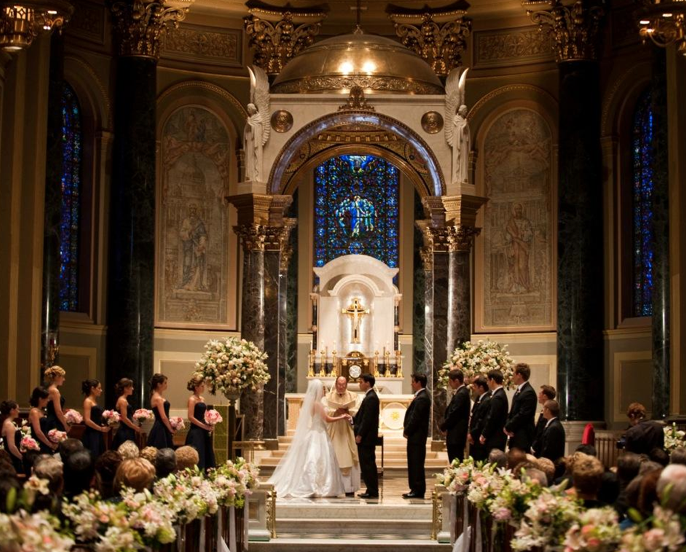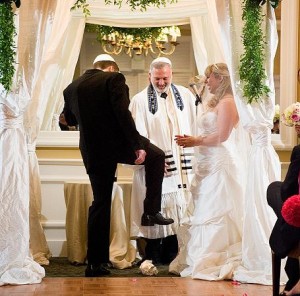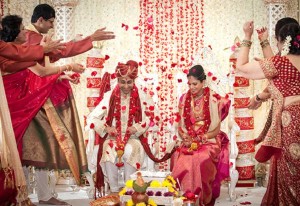Attending a religious or cultural wedding ceremony unfamiliar to you can be intimidating. Everyone wonders, “How do I behave and should I participate?” In this wedding ceremony guide, we have outlined the essentials of three common religious and cultural ceremonies – Catholic, Jewish and Indian weddings – so you can feel comfortable taking part in the celebration.

CATHOLIC WEDDINGS
Marriage is one of the seven sacraments of the Roman Catholic Church. Couples may opt to have a nuptial Mass following the exchange of vows. This Mass can only take place in a Catholic church and the mass plus wedding ceremony typically lasts about an hour. The ceremony includes the introductory rites, two readings selected by the couple, called Liturgy of the Word, a homily (or sermon) from the priest regarding marriage and the couple, the exchange of the vows and rings, prayers of the faithful, Communion and concluding rites.
YOU SHOULD KNOW …
Catholics stand and kneel to pray during certain parts of the mass. You may participate but are not required to do so. You can remain seated if you choose.
The nuptial Mass includes receiving Communion and is only for Catholic guests who have made their First Holy Communion. If you are not Catholic, you can simply remain in your seat. However, Communion does include a blessing; and to make everyone feel welcome anyone can receive this blessing. If you wish to be included for the blessing, you can join the processional to the altar, bow your head before the priest and he will lay his hands on your head and bless you.
After the Lord’s Prayer, the priest will invite guests to give each other the “Sign of the Peace.” This simply means to turn to those seated closest to you, shake hands and say, “Peace be with you.”
JEWISH WEDDINGS
 A religious Jewish ceremony takes place under a chuppah (marriage canopy), but does not necessarily need to be held in a synagogue. The ceremony typically lasts about half an hour and includes the bride walking around the groom seven times, the reading of the ketubah (marriage contract), the rabbi reciting the sheva berakhot (seven blessings) and sharing a cup of wine with the couple. The ceremony ends with the breaking of the glass.
A religious Jewish ceremony takes place under a chuppah (marriage canopy), but does not necessarily need to be held in a synagogue. The ceremony typically lasts about half an hour and includes the bride walking around the groom seven times, the reading of the ketubah (marriage contract), the rabbi reciting the sheva berakhot (seven blessings) and sharing a cup of wine with the couple. The ceremony ends with the breaking of the glass.
YOU SHOULD KNOW …
Upon entering the ceremony space, if you see a table set out with yarmulkes, be mindful that all male guests are expected to wear one regardless of their faith. Additionally, if the ceremony is taking place in a synagogue, there may be a box of head coverings for women. If these are present, ladies should don them also.
When dressing for a synagogue wedding, slacks for females are frowned upon and shoulders should be covered for the ceremony.
At the end of the ceremony, the groom will smash a napkin wrapped wineglass with his foot symbolizing the destruction of the Temple in Jerusalem. It also serves as a reminder that even in times of joy there is pain in the world.
You may receive an invitation with two different start times. The first time refers to the start of the kabbalat panim; this is the time to greet the bride and groom before the ceremony. The second time refers to the start time of the actual ceremony.
Depending on the couple’s level of observance, the wedding might take place on Thursday or Sunday due to restrictions on Shabbat, which runs from sundown on Friday to sundown on Saturday.
INDIAN WEDDINGS
 Indian weddings in the US are typically shorter than those held in India, where it’s a multi-day affair. Be advised, even in the US the ceremony can still last several hours and will take place under a mandap (canopy). The ceremony begins with the kanya daan, or the giving away of the bride. The couple then joins hands and circles a small fire pit known as an Agni followed by the saptapadi, ceremonious seven steps signifying their mutual support. Finally, the groom applies a red powder to the center of the bride’s forehead and ties a black beaded necklace around her neck, symbolizing her status as a married woman.
Indian weddings in the US are typically shorter than those held in India, where it’s a multi-day affair. Be advised, even in the US the ceremony can still last several hours and will take place under a mandap (canopy). The ceremony begins with the kanya daan, or the giving away of the bride. The couple then joins hands and circles a small fire pit known as an Agni followed by the saptapadi, ceremonious seven steps signifying their mutual support. Finally, the groom applies a red powder to the center of the bride’s forehead and ties a black beaded necklace around her neck, symbolizing her status as a married woman.
YOU SHOULD KNOW …
There are several important ceremonies that take place in the days before the wedding; the first is Misri – the ring ceremony.
The next ceremony before the wedding is Mehendi, taking place the day before the wedding at a ladies-only afternoon tea. Intricate henna drawings are applied to the ladies’ hands and feet as a symbol of the bond between the bride and groom.
Indian weddings are all about bold and bright colors so don’t be afraid to wear them.
Indian wedding traditions vary across religion, caste, ethnicity, language and region. Regardless of the religion, be respectful but not afraid to ask questions – quietly. It’s perfectly acceptable to discreetly ask a neighbor to explain a portion of the ceremony you don’t understand. Most importantly, enjoy yourself! You are there because the bride and groom wanted you there.
———————————————————————–
If you’re invited to a wedding with traditions unfamiliar to you, there is no need to feel uncomfortable. Enjoy the experience and consider it an opportunity to learn about other cultures. The common thread of all the different religious rituals and cultural traditions is this: a marriage is a joyous occasion worthy of celebration.
Do you have questions or comments about gift-giving or wedding etiquette? Please email us at AskCheryl@registryfinder.com. We will respond to your questions and may also use them as the subject of a future blog. We hope you’ve enjoyed this wedding ceremony guide.


fifa
this can be a very helpful web site!